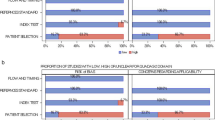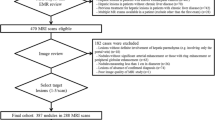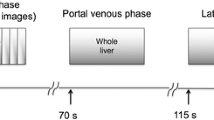Abstract
Purpose: To investigate the value of a new wide-band contrast harmonic imaging method in depicting intratumoral vascularity in hepatocellular carcinoma.Materials and Methods: Twenty-two patients with 28 hepatocellular carcinoma nodules evaluated with Contrast Harmonic Echo, a new wide-band harmonic imaging method, using Levovist® as a contrast-enhancing agent. Intermittent imaging was carried out in the early arterial phase for 10 to 40 seconds, in the late vascular phase for 1 to 2 minutes, and in the postvascular phase for 5 to 7 minutes. Subtraction images were obtained using the multishot method during the late vascular phase. The ability of Contrast Harmonic Echo imaging to detect vascularity in hepatocellular carcinoma was compared to that of unenhanced color Doppler imaging by analzing results obtained using dynamic CT as a gold standard.Results: Contrast harmonic Echo imaging detected intratumoral vessels, tumor parenchymal stain, and perfusion defect in the early arterial phase, the late vascular phase, and the postvascular phase, respectively. In the late vascular phase, the subtraction image clearly delineated the tumor parenchymal strain. Intratumoral vascularity was detected in 25 (89%) of the hepatocellular carcinoma nodules by Contrast Harmonic Echo, compared with 15 (54%) when color Doppler imaging was used (p<0.05). The diagnostic sensitivity, specificity, and accuracy of Contrast Harmonic Echo were 96.1%, 100% and 96.4%, respectively, corresponding to results obtained using dynamic CT.Conclusion: Contrast Harmonic Echo imaging is superior to unenhanced color Doppler imaging in depicting intratumoral vessels and parenchymal stain, and agrees closely with results obtained with three-phase dynamic CT.
Similar content being viewed by others
References
Takayasu K, Moriyama N, Muramatsu Y, et al: The diagnosis of small hepatocellular carcinoma: efficacy of various imaging procedures in 100 patients. AJR Am J Roentgenol 1990;155: 49–54.
Menu Y: Hepatocellular carcinoma-radiological findings. Hepatogastroenterol 1998;45: 1232–1235.
Kudo M: Morphological diagnosis of hepatocellular carcinoma: special emphasis on intranodular hemodynamic imaging. Hepatogastroenterol 1998;45: 1226–1231.
Kudo M: Imaging diagnosis of hepatocellular carcinoma and premalignant/borderline lesions. Semin Liver Dis 1999;19: 297–309.
Tanaka S, Kitamura T, Fujita M, et al: Color Doppler flow imaging of liver tumors. AJR Am J Roentgenol 1990;154: 509–514.
Koito K, Namieno T, Morita K: Differential diagnosis of small hepatocellular carcinoma and adenomatous hyperplasia with power Doppler sonography. AJR Am J Roentogenol 1998;170: 157–161.
Kawasaki T, Itani T, Nakase H, et al: Power Doppler imaging of hepatic tumors: differential diagnosis between hepatocellular carcinoma and metastatic adenocarcinoma. J Gastoenterol Hepatol 1998;13: 1152–1160.
Okuda K: Hepatocellular carcinoma: recent progress. Hepatology 1992;15: 948–961.
Kudo M, Tomita S, Tochio H, et al: Sonography with intraarterial infusion of carbon dioxide microbubbles (sonographic angiography): value in differential diagnosis of hepatic tumors. AJR Am J Roentgenol 1992;158: 65–74.
Ikeda K, Saito S, Koida I, et al: Imaging diagnosis of small hepatocellular carcinoma. Hepatology 1994;20: 82–87.
Takayasu K, Muramatsu Y, Furukawa H, et al: Early hepatocellular carcinoma: appearance at CT during arterial portography and CT arteriography with pathologic correlation. Radiology 1995;194: 101–105.
Leen E, McArdle CS: Ultrasound contrast agents in liver imaging. Clin Radiol 1996;51 (suppl): 35–39.
Cosgrove D: Ultrasound contrast enhancement of tumors. Clin Radiol 1996;51 (suppl): 44–49.
Calliada F, Campani R, Bottinelli O: Ultrasound contrast agents: basic principles. Eur J Radiol 1998;27: s157-s160.
Maresca G, Summaria V, Colagrande C: New prospects for ultrsound contrast agents. Eur J Radiol 1998;27: s171-s178.
Burns PN: Harmonic imaging with ultrasound contrast agents. Clin Radiol 1996;51 (suppl): 50–55.
Kono Y, Moriyasu F, Mine Y, et al: Gray-scale second harmonic imaging of the liver with galactose-based microbubbles. Invest Radiol 1997;32: 120–125.
Wilson SR, Burns PN, Muradali D, et al: Harmonic hepatic US with microbubble contrast agent: initial experience showing improved characterization of hemangioma, hepatocellular carcinoma, and metastasis. Radiology 2000;215: 153–161.
Choi BI, Kim TK, Han JK, et al: Vascularity of hepatocellular carcinoma: assessment with contrast-enhanced second-harmonic versus conventional power Doppler US. Radiology 2000;214: 381–386.
Kim TK, Choi BI, Han JK, et al: Hepatic tumors: contrast agent-enhancement patterns with pulseinversion harmonic US. Radiology 2000;216: 411–417.
Burn PN, Wilson SR, Simpson DH: Pulse inversion imaging of liver blood flow: improved method for characterizing focal masses with microbubble contrast. Invest Radiol 2000;35: 58–71.
Ding H, Kudo M, Onda H, et al: Contrast-enhanced subtraction harmonic sonography for evaluating treatment response in patients with hepatocellular carcinoma. AJR Am J Roentgenol 2001;176: 661–666.
Numata K, Tanaka K, Kiba T, et al: Contrast-enhanced, wide-band harmonic gray scale imaging of hepatocellular carcinoma: correlation with helical computed tomographic findings. J Ultrasound Med 2001;20: 89–98.
Strobel D, Krodel U, Martus P, et al: Clinical evaluation of contrast-enhanced color Doppler sonography in the differential diagnosis of liver tumors. J Clin Ultrasound 2000;28: 1–13.
Kim AY, Choi BI, Kim TK, et al: Hepatocellular carcinoma: power Doppler US with a contrast agent: preliminary results. Radiology 1998;209: 135–140.
Forsberg F, Liu JB, Burns PN, et al: Artifacts in ultrasonic contrast agent studies. J Ultrasound Med 1994;13: 357–365.
Kamiyama N, Moriyasu F, Mine Y, et al: Analysis of flash echo from contrast agent for designing optimal ultrasound diagnostic systems. Ultrasound Med Biol 1999;25: 411–420.
Kamiyama N, Moriyasu F, Kono Y, et al: Investigation of the “flash echo” signal associated with a US contrast agent. Radiology 1996;201 (p): 158.
Author information
Authors and Affiliations
About this article
Cite this article
Wen, Y.L., Kudo, M., Minami, Y. et al. Value of new contrast harmonic technique for detecting tumor vascularity in hepatocellular carcinoma: Preliminary results. J Med Ultrasonics 30, 85–92 (2003). https://doi.org/10.1007/BF02481368
Received:
Accepted:
Issue Date:
DOI: https://doi.org/10.1007/BF02481368




